Effective Pest Control for Peach Trees
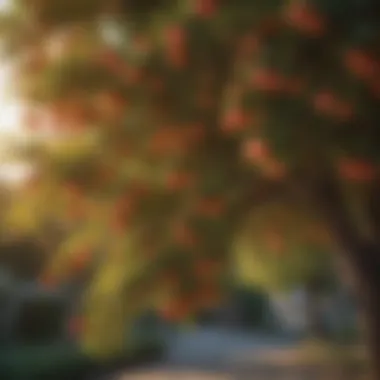
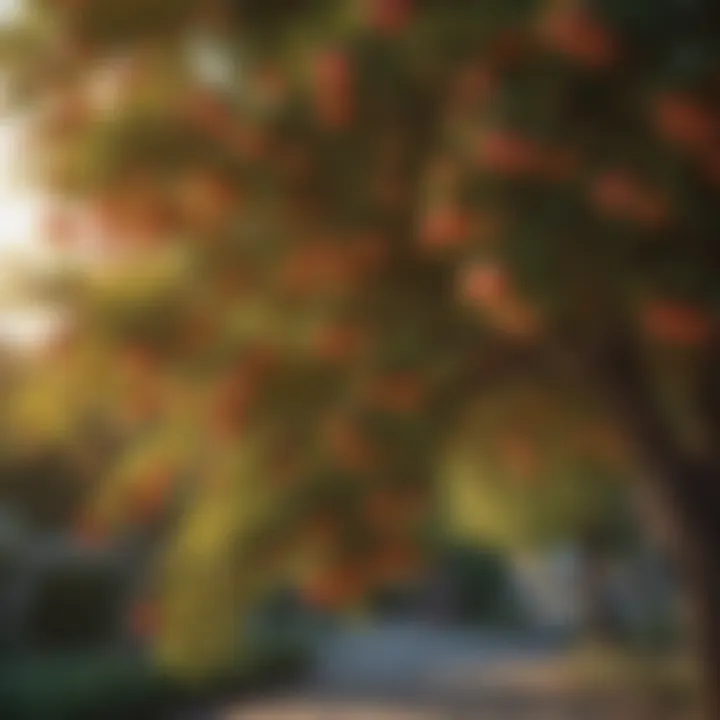
Intro
Peach trees, cherished for their sweet fruit and delicate blossoms, can be vulnerable to a multitude of pests and diseases. To cultivate a bountiful peach harvest, effective pest control strategies are crucial. This guide will explore fundamental techniques aimed at both novice and seasoned gardeners. Through a focus on pest identification, prevention, and environmentally sustainable management, we aim to empower homeowners in maintaining healthy peach orchards.
Understanding Pests
Definition of Pests
Pests refer to organisms that compete with humans for food, resources, and space. In the context of peach trees, these include insects, weeds, fungi, and bacteria that hinder growth or damage fruit and foliage. Understanding what constitutes a pest can help gardeners develop appropriate management strategies.
Importance of Pest Identification
Identifying pests accurately is critical for effective control. Correct identification allows gardeners to distinguish between harmful insects and beneficial ones. For instance, aphids may infest peach trees, but ladybugs, which consume aphids, are beneficial. Monitoring pests and quickly responding to their presence can save trees from significant damage.
"Effective pest management starts with knowing your enemy. Knowing the pests enables precise action, leading to healthier trees and improved yields."
Prevention Techniques
Home and Garden Preventative Measures
Preventive strategies form the backbone of pest control. Simple measures can significantly reduce the likelihood of infestations:
- Regular Inspections: Routinely checking trees for early signs of pests or diseases helps catch issues before they escalate.
- Proper Pruning: Trimming away dead or crowded branches improves air circulation, reducing disease risk.
- Maintaining Soil Health: Healthy soil fosters strong trees. Use organic compost and mulch to nourish your peach trees.
Seasonal Prevention Tips
The timing of preventive actions can make a significant difference in pest management effectiveness:
- Spring Preparation: Apply dormant oil in early spring to suffocate overwintering pests.
- Summer Vigilance: Monitor for pests like spider mites as temperatures rise; they thrive during hot summer months.
- Fall Cleanup: Remove fallen leaves and fruit to prevent the spread of diseases to the next growing season.
Eco-Friendly Pest Control Solutions
Overview of Sustainable Practices
Sustainability should guide pest control strategies. Eco-friendly practices can be as effective as conventional ones while preserving the environment. Integrated Pest Management (IPM) offers a well-rounded approach, combining biological, cultural, physical, and chemical tools:
- Encourage Beneficial Insects: Attract predators like lacewings and hoverflies that help combat pest populations.
- Crop Rotation: Avoid planting peach trees in the same location annually. This prevents the buildup of soil-borne pests.
Natural Remedies and Their Effectiveness
Natural remedies can supplement standard pest control measures. While effectiveness may vary, they provide environmentally friendly options:
- Neem Oil: Derived from the seeds of the neem tree, it disrupts the reproductive cycle of pests.
- Soap Sprays: Simple soap solutions can break down insect exoskeletons, eliminating small pests.
- Diatomaceous Earth: This natural substance can deter crawling insects by damaging their exoskeletons.
By adopting these strategies, peach tree caretakers can protect their trees against pests while promoting an environmentally sound approach to gardening. Emphasizing prevention, identification, and sustainable methods will lead to healthier fruit trees and more satisfying harvests.
Prelude to Peach Tree Pests
Peach trees are a valued addition to any garden. However, they can be vulnerable to a range of pests that demand careful attention. Understanding these pests is pivotal to successful cultivation. This section discusses the importance of pest management and highlights common pests that affect peach trees.
Importance of Pest Management
Effective pest management is essential for the healthy growth and productivity of peach trees. Without proper control measures, pests can cause significant harm, leading to reduced yields or even tree loss. Effective management practices ensure a sustainable approach that protects not only the trees but also the broader ecosystem. By addressing pest issues promptly, gardeners can achieve both healthy peach trees and fruit that is safe to consume.
Common Pests Affecting Peach Trees
Peach trees face threats from various pests, which can negatively impact their health. Familiarity with these pests allows for better scouting and prevention strategies. The most notable pests affecting peach trees include:
Peach tree borer
The peach tree borer poses a significant threat to these trees. Adult borers lay their eggs at the base of the tree. Once the eggs hatch, larvae burrow into the bark and wood, which can be detrimental. The key characteristic of the peach tree borer is its ability to cause internal damage that is often hard to see until it is too late. This pest is a popular choice for discussion in pest management due to its widespread issues across various peach-growing regions, showing the need for effective strategies to combat it.
Aphids
Aphids are small, soft-bodied insects that feed on the sap of peach trees. They reproduce quickly and can lead to yellowing leaves and stunted growth. What makes aphids particularly noticeable is their tendency to form colonies; a single tree can host hundreds of them. This pest is discussed for its damaging effects on tree health and its capacity to transmit viruses. Gardeners need to be vigilant about monitoring them as infestations can develop rapidly.
Spider mites
Spider mites are not true insects but are arachnids that can harm peach trees. They thrive in hot, dry conditions and feed on the undersides of leaves. The damage appears as stippling or bronzing of foliage. A key characteristic of spider mites is their webbing, which can signal the presence of an infestation. This pest is included in the discussion as it can cause significant stress to the trees, especially if left unchecked. Their rapid reproduction rates make them a common concern for gardeners.
Fruit flies
Fruit flies, specifically the oriental fruit fly, target ripe peaches, laying eggs inside the fruit. The larvae then feed on the flesh, making the fruit inedible. One of the defining features of fruit flies is their ability to quickly gather in large numbers, exacerbating the problem. Their inclusion in pest management conversations is crucial, as they can have a direct impact on yield and marketability. Understanding their lifecycle aids gardeners in developing effective control methods.
Identifying Peach Tree Pests
Identifying pests that threaten peach trees is crucial for successful pest management. Recognizing the signs of infestation early can prevent severe damage, ensuring the health of the trees and the quality of the fruit. A systematic approach to identification allows gardeners to take timely and appropriate action against harmful pests. Understanding the specific characteristics of pests helps to differentiate between harmful insects and beneficial ones, reducing unnecessary interventions.
Signs of Infestation
Foliage damage
Foliage damage is a primary indication that pests have invaded peach trees. Leaves may show signs of being chewed, curled, or discolored. This damage significantly contributes to the overall health of the tree because leaves are essential for photosynthesis. An early warning signal like this can help gardeners assess the severity of an infestation and take corrective measures promptly.
One key characteristic of foliage damage in a pest scenario is the visibility of holes or irregular edges on leaves. This is a common example of insect feeding, particularly from pests like aphids or spider mites. Understanding these signs is beneficial for developing a targeted treatment plan.

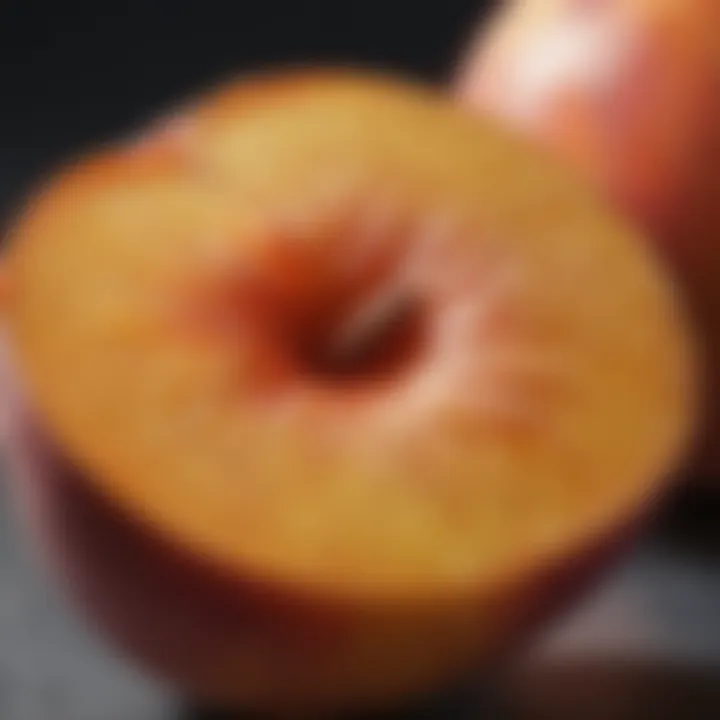
However, foliage damage can also have some drawbacks. Not all damaged leaves result from pests; environmental factors such as drought or disease can also cause similar symptoms. Thus, while foliage damage is a crucial indicator, further investigation is necessary to confirm the culprit.
Fruit deformities
Fruit deformities often manifest as abnormal shapes, discoloration, or even premature drop. This specific aspect plays a significant role in the overall yield of the crop. Unusually deformed or damaged fruit can reduce market value and consumer appeal. Identifying fruit deformities allows gardeners to link them to specific pests like fruit flies, which are notorious for causing this type of damage.
A key characteristic of these deformities is their visible irregularity. This may include growths, scars, or sunken areas on the fruit. Observing these signs can help in developing an effective pest management plan to protect the quality of the harvest.
On the downside, fruit deformities might arise from several factors, including nutritional deficits or weather conditions. This potential for confusion means that accurate diagnosis is essential before imposing any treatments.
Presence of webs
The presence of webs on peach trees can signal the existence of spider mites. This aspect of pest identification is important because it usually indicates a more established infestation, which can lead to significant damage over time. Webs can disrupt the tree’s respiration and photosynthesis processes, underscoring the need for prompt attention.
A key characteristic of webs is their fine and silk-like appearance, often found in the leaf axils or on the undersides of leaves. This makes identification straightforward, as webs are not commonly mistaken for other natural structures. The presence of these webs serves as a beneficial indicator for gardeners, alerting them to the necessity of monitoring and potential intervention.
However, webs can sometimes be confused with natural silk from other creatures, making proper identification necessary. This issue highlights the need for careful observation and understanding of specific pest behavior.
Visual Identification Techniques
Observation methods
Observation methods are fundamental for recognizing peach tree pests effectively. These techniques involve visually inspecting trees for signs of life and damage. They serve as a primary and cost-effective means to monitor pest populations. Regular observation helps identify problems early, enabling timely interventions.
One key characteristic of observation methods is the ease of implementation; gardeners do not need specialized tools or training to begin monitoring. Simple checks can reveal signs of trouble, providing a straightforward approach to pest management.
However, one limitation of observation methods is that some pests may be small or hidden, requiring more advanced techniques to locate them. This calls for continued learning and adaptation as issues arise.
Using magnification tools
Using magnification tools can significantly enhance the identification process of pests. Tools such as hand lenses or microscopes allow for a closer examination of leaves and fruit. This method helps spot small insects or eggs that are otherwise invisible to the naked eye. The increased detail contributes greatly to precise identification.
A key characteristic of using magnification tools is their ability to reveal the intricate details in pest morphology, which aids in accurate identification. This clarity is particularly beneficial in discerning between similar pest species.
Nonetheless, depending on such tools may pose a challenge for some gardeners who may feel uncomfortable using them. Familiarity with these tools can take time, deeming patience necessary while learning.
Consulting identification guides
Consulting identification guides is an essential practice for identifying peach tree pests accurately. These guides provide valuable resources packed with images and descriptions that facilitate better understanding of pest characteristics. When utilized effectively, these guides can bridge the knowledge gap for gardeners confronting unfamiliar pests.
A key characteristic of identification guides is that they offer structured information that can be easily followed. This organized approach makes it easier for gardeners to narrow down possibilities based on observed symptoms or signs.
On the downside, guides can sometimes lack up-to-date information regarding specific regional pest variations. This side effect may lead to misidentification and ineffective treatment strategies. Relying solely on guides without other confirming methods might limit effectiveness.
Integrated Pest Management (IPM) Approach
Integrated Pest Management (IPM) is a holistic approach that blends different control strategies to effectively manage pests affecting peach trees. This method is essential as it promotes sustainable practices while maximizing the yield and health of peach crops. IPM is rooted in understanding the life cycles and behaviors of pests, which allows for timely and appropriate interventions. Key aspects of IPM include cultural, biological, and chemical controls, which together form a balanced and environmentally safe pest management strategy.
Principles of IPM
The principles of IPM revolve around several core concepts aimed at reducing pest populations to acceptable levels without relying solely on chemical treatments. By integrating various strategies, IPM seeks to create a long-term pest management solution.
- Pest Knowledge: Understanding the specific pests that threaten peach trees, including their life cycles, behaviors, and environmental preferences is vital. This knowledge aids in making informed decisions.
- Monitoring: Regular monitoring of pest populations helps in identifying outbreaks early on. Use of traps and inspection techniques supports this principle.
- Action Thresholds: Setting action thresholds allows growers to determine when pest populations require intervention. This prevents unnecessary pesticide application and reduces exposure.
- Integration of Controls: Utilizing a mix of biological, cultural, and chemical methods creates a comprehensive approach that can effectively lower pest populations. This integration minimizes the risks associated with conventional agriculture, such as resistance development.
Cultural Controls
Cultural controls are techniques that modify the environment to suppress pest populations, thus creating conditions unfavorable for them while enhancing the health of peach trees. These methods are often the first line of defense against pests.
Selecting resistant varieties
Selecting resistant varieties of peach trees plays a crucial role in pest management. These varieties are bred to tolerate or resist specific pests and diseases, reducing reliance on chemical controls. The key characteristic of these varieties is their genetic makeup, which gives them the ability to withstand certain pest pressures. This choice is beneficial as it enhances the resilience of orchards and can lead to healthier yields. Unique features include their adaptability to local climatic conditions, which adds to their advantages. However, it’s important to note that complete resistance is not guaranteed, and pests may still pose a threat under certain conditions.
Proper tree spacing
Proper tree spacing is another important cultural control. Adequate spacing between peach trees reduces crowding, which can foster pest outbreaks by increasing humidity and limiting air circulation. The key characteristic of this practice is its emphasis on creating a healthier microenvironment. By allowing sufficient space, it minimizes the chances of infestation. The unique feature of tree spacing is its dual benefit; not only does it discourage pests, but it also allows each tree to access adequate sunlight and nutrients for optimal growth. However, careful consideration of the natural growth patterns of the specific peach varieties is necessary to prevent underutilization of the planting area.
Soil management
Soil management is essential for maintaining healthy peach trees and mitigating pest issues. Healthy soil promotes robust root systems and overall plant vigor, making them less susceptible to pests. The key characteristic of soil management is the focus on maintaining balance and nutrient levels in the soil. This approach is beneficial as it enhances tree health, making it a pivotal practice in overall pest control strategy. Unique features include implementing practices like cover cropping and crop rotation, which improve soil structure and fertility. Still, the challenge lies in the initial effort to improve soil health, which may require time and investment before yielding visible results.
"IPM encourages informed decisions, weighing the risks and benefits of each strategy for the environment and the yields of peach trees."
Integrating these cultural controls into your pest management strategy provides a strong foundation for reducing pest impacts and promoting thriving peach trees.
Biological Control Methods
Biological control methods are an essential aspect of effective pest management for peach trees. This approach utilizes natural predators and parasites to regulate pest populations instead of relying on synthetic chemicals. The primary benefit of biological control is its eco-friendly nature. It helps maintain the ecological balance while minimizing harm to the environment and non-target organisms. Moreover, integrating biological methods can reduce the risks associated with chemical residues on fruit.
Beneficial Insects
Lacewings
Lacewings are often regarded as significant allies in pest management. Their larvae, known as aphid lions, actively consume a wide range of soft-bodied pests. This makes lacewings a popular option for peach tree care. A key characteristic of lacewings is their voracious appetite for pests like aphids and spider mites. This unique feature enables them to effectively control pest populations, leading to healthier peach trees. However, availability can be an issue, as their natural habitat may not always support their numbers.
Ladybugs
Another important beneficial insect is the ladybug. These insects are renowned for their appetite for aphids. This makes them particularly useful in any strategy aimed at managing pests that threaten peach trees. A distinctive feature of ladybugs is their ability to consume large quantities of pests in a short time. One advantage of utilizing ladybugs is their widespread availability and ease of introduction into orchards. On the downside, ladybugs may migrate away from an area once they consume local pest populations, which can limit their long-term effectiveness.
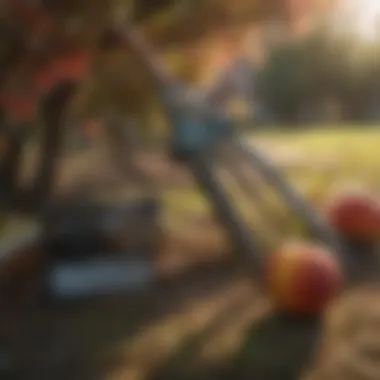
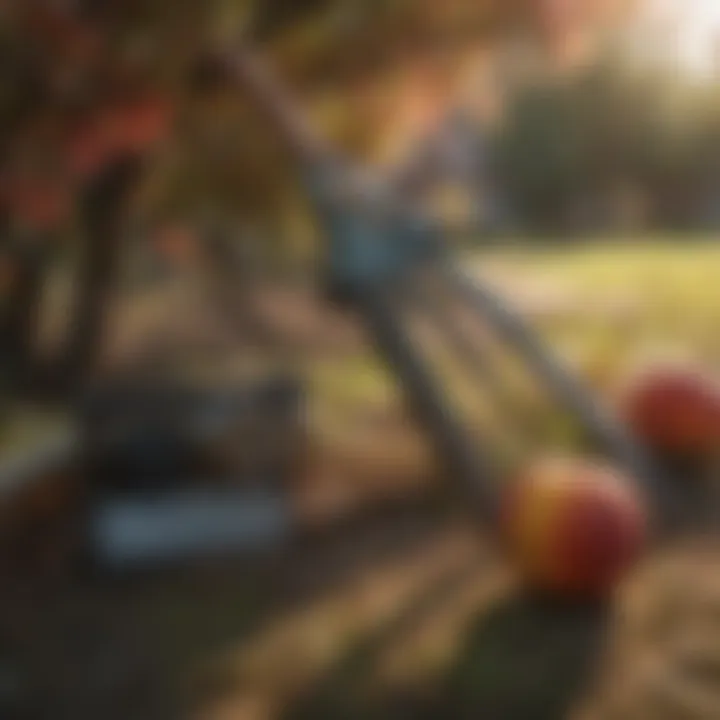
Parasitic Wasps
Parasitic wasps serve as specialists in biological pest control. These insects lay their eggs inside or on the bodies of pest insects, essentially using them as hosts for their developing larvae. This process can significantly reduce pest populations, particularly in cases of caterpillars and similar pests. A notable advantage of parasitic wasps is their specificity, which means they typically target only particular pest species. This minimizes the risk of harming beneficial insects. However, their effectiveness relies on the presence of suitable host pests, which can vary with seasonal changes.
Microbial Control Agents
Bacillus thuringiensis (Bt)
Bacillus thuringiensis, commonly referred to as Bt, is a bacterium used widely in organic pest control. It produces toxins that can be extremely effective against specific insect pests, particularly caterpillars. The primary benefit of using Bt is its selectivity; while it targets harmful insects, it poses little risk to beneficial organisms. This makes it suitable for integrated pest management strategies. Nonetheless, proper timing is crucial, as its effectiveness decreases with higher temperatures.
Nematodes
Nematodes are microscopic roundworms that are valuable in pest control. They enter the bodies of soil-dwelling pests, killing them rapidly. An essential aspect of nematodes is their consistency in controlling certain root and soil pests, which can be a significant issue for peach trees. They are a favorable option because they are naturally occurring and pose no harm to plants or humans. However, nematodes are sensitive to environmental conditions, and their success depends on maintaining suitable soil moisture levels.
Utilizing biological control methods not only protects your peach trees but also supports sustainable gardening practices that benefit the environment.
Chemical Control Options
Chemical control is a vital component of pest management for peach trees. This approach includes various pesticides designed to effectively eliminate or reduce pest populations. It is essential to understand the importance of using chemical controls wisely. Over-reliance can lead to pest resistance and detrimental effects on beneficial organisms. Therefore, incorporating these techniques responsibly can significantly contribute to the health and productivity of peach trees.
Types of Pesticides
Contact pesticides
Contact pesticides work by entering the pest's body upon contact. One advantage of using these pesticides is their quick action against immediate pest threats. This makes them a popular choice among gardeners. A unique feature of contact pesticides is that they typically affect only the insects that come into contact with the sprayed surface, limiting exposure to surrounding plants and organisms. However, they may require repeated applications, especially after rainfall, which can wash the pesticides away.
Systemic pesticides
Systemic pesticides are absorbed by the plant and transported throughout its tissues. The main benefit of this type is that they offer long-lasting protection, as pests ingest the chemical while feeding on the plant. This ensures a more targeted approach to dealing with pests. The characteristic of systemic pesticides makes them a favored option. However, some systemic pesticides can negatively affect beneficial insects, leading to an imbalance in the ecosystem around the fruit trees.
Organic options
Organic pesticides are derived from natural sources and are designed to minimiize environmental impact. Their importance lies in the growing interest among consumers for sustainable and chemical-free produce. Organic options, while effective, tend to have shorter residual activity compared to synthetic pesticides. This means that they may need more frequent applications, particularly in environments with high pest pressure. The unique feature of these options is their alignment with organic farming principles, making them a suitable choice for those looking to maintain eco-friendly practices.
Application Techniques
Application techniques play a crucial role in the effectiveness of pesticide use. Properly executed, these techniques can mitigate the risks associated with chemical applications.
Timing of application
The timing of application is critical for achieving the best results with any pesticide. Applying pesticides at the right time ensures maximum effectiveness while minimizing potential harm to beneficial species. This requires careful planning and observation of pest life cycles. The characteristic aspect of timing lies in synchronizing applications with peak pest activities. However, incorrect timing can lead to reduced efficacy, wasting both time and resources.
The role of weather
Weather conditions significantly influence the efficacy of pesticide application. Factors such as temperature, humidity, and wind can affect how well a pesticide works. For instance, a windy day can lead to drift, causing pesticides to affect non-target plants. This introduction of environmental considerations makes understanding the role of weather essential for successful pest control. However, unpredictable weather may hinder timely applications, necessitating flexibility in planning pest treatments.
Proper calibration of equipment
Proper calibration of equipment is vital in ensuring the correct amount of pesticide is applied. Over-application can lead to increased costs and potential harm to the ecology. Ensuring that the equipment is set to the desired specifications helps optimize the effectiveness of the pesticide applied. The main characteristic of proper calibration is that it maximizes coverage and minimizes waste. On the downside, calibration requires time and attention, which might be a challenge for some gardeners but leads to better pest management results.
Preventive Measures
Preventive measures are vital in managing pest issues effectively on peach trees. They focus on proactive strategies that reduce the chances of pest infestations occurring in the first place. By understanding and implementing these measures, gardeners can maintain healthier trees and reduce the need for more intensive control methods later on. This leads to higher quality fruit yields and minimizes reliance on potentially harmful chemicals.
Regular Monitoring
Regular monitoring is the cornerstone of any effective pest management strategy. It allows gardeners to catch potential issues early, ensuring that any pest problems can be dealt with promptly.
Weekly inspections
Weekly inspections serve as a proactive measure to identify any early signs of infestation. Conducting these inspections helps in observing changes to the foliage and fruit.A key characteristic of these inspections is their frequency. Regular checks increase the likelihood of noticing threats before they escalate. The beneficial aspect of weekly inspections is their ability to help in recognizing pest activity and damage. Therefore, it becomes possible to act early. One disadvantage might be the time commitment required to perform thorough inspections weekly, especially for larger gardens.
Use of traps
Using traps is also an effective method of monitoring pest populations. Traps can attract and capture pests, providing gardeners with insight into what might be affecting their peach trees. A notable characteristic of traps is their ability to function continuously. They work even when the gardener is not present, giving a reliable overview of pest activity. Traps are a popular choice due to their simplicity and effectiveness at detecting pest presence without requiring much effort. However, traps can sometimes mislead if they catch non-target species, which may confuse assessment efforts.
Sanitation Practices
Sanitation practices play a crucial role in maintaining an environment where pests are less likely to thrive. Keeping the orchard clean helps in reducing the sources of pest attraction and breeding grounds.
Cleansing plant debris
Cleansing plant debris is an essential practice that involves removing fallen leaves, twigs, and other organic matter. This practice helps to minimize potential pest shelters and breeding sites. A vital characteristic of cleansing plant debris is its preventive nature. It acts as a barrier against pests that thrive in decaying matter. This practice is widely seen as a beneficial choice for maintaining plant health because it disrupts pest life cycles. One disadvantage can be the labor involved, especially during heavy shedding periods when more effort is needed to clear the ground.
Managing fallen fruit
Managing fallen fruit is another pivotal sanitation practice. Fallen fruits can attract numerous pests, including fruit flies and other insects. A key characteristic of managing fallen fruit is its ability to eliminate food sources that might lure pests. This makes it an effective action to reduce pest outbreaks. This practice is a beneficial measure as it directly addresses pest attraction. Nevertheless, it may require frequent attention, especially during harvest seasons when fruit drop tends to be higher.
Proper preventive measures are essential in sustaining the health of peach trees and ensuring productive yields. Without them, pests can lead to devastating losses.
Seasonal Pest Management Strategies
Seasonal pest management is a critical component of maintaining healthy peach trees. Managing pest populations effectively throughout the various seasons helps to minimize damage and improve overall tree health. Each season brings its own challenges and opportunities for pest control. By understanding the specific pests that are active during each season and adapting strategies accordingly, gardeners can create a more comprehensive approach to pest management.
Pest populations fluctuate with seasonal changes. Early intervention in spring can prevent issues from escalating in summer when pests thrive. Moreover, implementing strategies in fall and winter prepares trees for the following year's growth cycle and pest presence. This proactive management approach ensures that interventions are timely and effective.
Spring Care
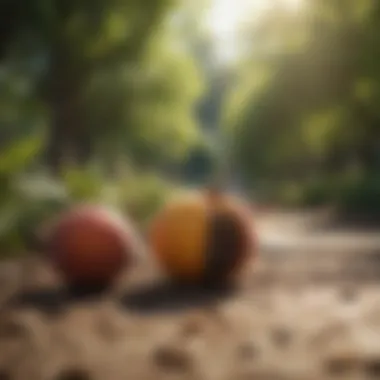

Spring marks the beginning of a new growth cycle for peach trees. As the weather warms, pests such as aphids and spider mites often emerge. Regular monitoring and inspections during this period are critical.
- Inspect foliage regularly to identify pest presence early.
- Consider applying suitable pesticides if thresholds of pests are observed.
- Encourage beneficial insects by planting companion plants that attract them.
By taking these actions, the foundation for a healthy pest-free growing season can be established. Preventative measures are more effective than reactive ones, so taking this initial step is vital.
Summer Approaches
During the summer months, pest populations can explode due to favorable conditions. This is the time when diligent observation and care are essential.
- Regular Monitoring: Continue to inspect trees weekly. Note any signs of damage or infestation, such as discolored leaves or the appearance of webs.
- Water Management: Proper watering regimes can strengthen the trees, making them less susceptible to pests. Keep soil moisture balanced, as drought stress can weaken trees and attract pests.
- Use of Traps: Employ sticky traps or pheromone traps to monitor specific pests like fruit flies. These tools can provide insights into pest populations and effectiveness of control measures.
By actively managing pests during the summer, you can mitigate damage and maintain the health of your trees.
Fall and Winter Preparations
As summer wanes, preparing for the upcoming seasons is crucial. Both pests and diseases can persist through the winter, so implementing a solid plan sets the stage for healthier fruit growth come spring.
- Sanitation: Remove fallen leaves and debris around the base of the trees. This practice eliminates potential overwintering spots for pests.
- Pruning: Trim away any dead or diseased branches to minimize disease spread and improve air circulation around the tree.
- Mulching: Applying mulch can protect root systems and deter certain pests. Choose organic mulch for the additional benefit of improving soil health.
Overall, preparing during the fall and winter is as important as managing during growing seasons. Pest management is a cycle that requires attention year-round to ensure fruitful peach trees.
Evaluating Pest Control Effectiveness
Evaluating the effectiveness of pest control methods is a critical component in managing peach tree health. It allows gardeners to assess the impact of their strategies and make informed decisions for future interventions. By understanding how to evaluate pest control, one can identify successful tactics while also recognizing areas in need of improvement.
Key elements in evaluating effectiveness include monitoring pest populations and analyzing crop yield. This approach provides a comprehensive view of how well pest control measures are functioning within the orchard. Continuous evaluation is not just beneficial for the immediate outcome; it also establishes a foundation for long-term sustainability in pest management. As environmental concerns become more paramount in agriculture, the ability to demonstrate effective pest control is relevant for both economic and ecological reasons.
Monitoring Pest Populations
Monitoring pest populations is essential for effective pest control in peach trees. Regular assessments help identify if pest numbers are increasing or decreasing and inform any necessary action.
Some techniques for monitoring include:
- Visual inspections: Checking for visible signs of pests on leaves, stems, and fruit.
- Trapping: Using sticky traps or pheromone traps can help capture certain pests. This can provide an estimate of pest populations.
- Data logs: Keeping a record of pest sightings and treatments offers insight into trends over time.
The advantage of monitoring pest populations is its proactive nature. Instead of reacting after damage, gardeners can act before infestations spread. Monitoring also helps in determining the right timing for pesticide application if necessary, ensuring that interventions are both timely and effective.
Analyzing Crop Yield
Analyzing crop yield is a significant step in evaluating pest control effectiveness. Yield data provides insights into how successful pest management strategies have been in safeguarding tree productivity. A reduction in pest populations should ideally translate into increased yields.
Considerations for analyzing crop yield include:
- Comparative analysis: Comparing yield data from previous years can highlight improvements or declines, giving context to pest management efforts.
- Quality checks: Examining the quality of the fruit, including size and disease presence, can give an indication of how pests have affected overall harvest quality.
- Documentation of treatment impacts: Keeping detailed records of pest control measures and their timing provides a clearer picture of their effects on yield.
Through careful analysis of crop yield, gardeners can refine their management strategies. If a specific insecticide or biological pest control was used, noting the effects on subsequent harvests may yield valuable insights.
Evaluating pest control effectiveness requires diligence and a systematic approach but ultimately leads to healthier peach trees and better yields.
Challenges in Peach Tree Pest Control
Pest control in peach orchards presents several challenges that need understanding and strategic planning. These challenges can significantly impact the health of the trees and the quality of the fruit. Pest populations can change quickly, and they may develop resistance to commonly used pesticides. This necessitates a comprehensive approach to pest management.
Importance of Addressing Challenges
Understanding these challenges is essential for successful peach tree cultivation. Not only do unresolved pest issues affect yield and quality, but they also influence the overall sustainability of the farming practices employed. By mastering these obstacles, gardeners can cultivate healthier trees and achieve a productive harvest.
Resistance Development
Resistance development is a significant concern in pest control. Over-reliance on specific chemical treatments can lead to a reduced effectiveness of these products. Pests that survive initial treatments may pass their resistant traits to future generations. As a result, the farmer may need to use higher doses or switch to more potent chemicals.
To combat resistance, it is important to rotate different types of pesticides. Utilizing various modes of action can help delay the development of resistant populations. Moreover, incorporating non-chemical strategies such as introducing beneficial insects can enhance control while reducing reliance on chemical inputs.
It is also crucial to follow pesticide application guidelines. These guidelines suggest proper dosages and timing, which can minimize the risk of resistance. Maintaining records of pest management actions can help in understanding pest trends and planning appropriately.
Environmental Concerns
Environmental concerns are another key aspect of managing pests in peach orchards. Chemical pesticides can have unintended consequences on surrounding ecosystems. They may negatively impact beneficial organisms, such as bees and other pollinators, which are crucial for fruit set. Additionally, these chemicals can contaminate soil and water sources if not managed properly.
A focus on integrated pest management (IPM) can help address these environmental issues. This approach promotes the use of cultural, biological, and mechanical control methods alongside selective chemical applications.
Regular monitoring of pest populations can contribute to identifying the most effective and environmentally safe control methods. Educating garden owners about proper disposal of chemical containers and any surplus pesticides also ensures minimal impact on the environment.
"Sustainable practices in peach tree pest control not only protect the trees but also preserve our environment for future generations."
The End
In addressing pest control strategies for peach trees, a conclusion serves as a synthesis of vital information outlined throughout the article. It allows readers to reflect on effective methodologies for maintaining healthy peach orchards, especially in the context of sustainable practices. By recognizing and summarizing key points, one can better appreciate the complexity of pest management and its importance in safeguarding both yield and tree health.
Summarizing Key Points
The discussion on peach tree pest control has highlighted several crucial elements:
- Understanding Pest Types: Identification of common pests like the peach tree borer, aphids, and fruit flies is fundamental.
- Integrated Pest Management (IPM): Employing IPM reduces reliance on chemicals through a combination of biological control, cultural practices, and monitored pesticide use.
- Preventive Measures: Consistent monitoring and sanitation practices help in early detection and management of potential infestations.
- Seasonal Strategies: Each season demands specific attention and care to cater to the unique challenges posed by pests at different growth stages of the peach tree.
- Evaluation of Methods: Monitoring pest populations and crop yields provides feedback essential to refine ongoing pest control strategies.
This encapsulation fosters a comprehensive understanding that empowers peach tree cultivators to make informed decisions.
Future Directions in Pest Management
As the landscape of agriculture continues to evolve, the future direction of pest management will likely embrace the following considerations:
- Innovative Biological Controls: Research into additional beneficial insects and microbial agents may yield novel alternatives to traditional strategies.
- Technology Integration: Precision agriculture tools, including drones and advanced monitoring systems, will enhance real-time decision-making in pest management.
- Increased Emphasis on Sustainability: Future practices will prioritize eco-friendly solutions, aligning with growing consumer interest in sustainably produced fruits.
- Climate Considerations: As climate affects pest behavior, adaptive strategies will be necessary to address changing patterns of pest prevalence in varying conditions.
- Community Involvement: Engaging with local horticultural communities and sharing knowledge can promote collaborative efforts to combat pest issues effectively.
By considering these directions, peach tree caretakers can remain ahead of pest challenges, ensuring fruitful orchards for years to come.



